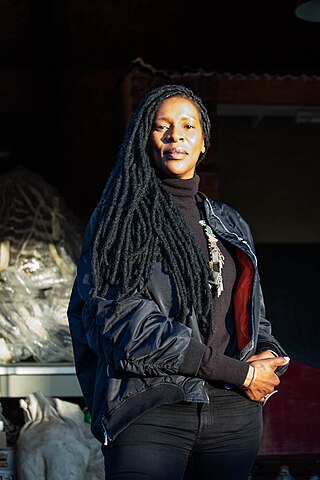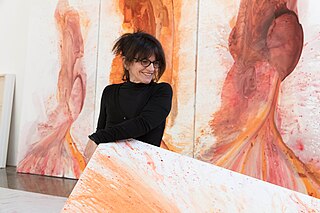David Goldblatt HonFRPS was a South African photographer noted for his portrayal of South Africa during the period of apartheid. After apartheid had ended he concentrated more on the country's landscapes. What differentiates Goldblatt's body of work from those of other anti-apartheid artists is that he photographed issues that went beyond the violent events of apartheid and reflected the conditions that led up to them. His forms of protest have a subtlety that traditional documentary photographs may lack: "[M]y dispassion was an attitude in which I tried to avoid easy judgments. . . . This resulted in a photography that appeared to be disengaged and apolitical, but which was in fact the opposite." He has numerous publications to his name.
Brett Murray is a South African artist mostly known for his steel and mixed media wall sculptures. He was born in Pretoria, South Africa. Murray has a master's degree in fine art from the Michaelis School of Fine Art, 1989. Referred to by critic Brenda Atkinson as "the dark prince of South African pop (art)", Murray is one of the country's most popular artists, often using easily recognisable media images with the addition of a subversive and bitterly funny twist. Murray's work addresses the wars of the cultures, the clash between Afrocentrism and Eurocentrism, the old and the new South Africas. "With my work I hope to critically entertain. Through satirical and tragic reflections on South Africa, I hope to shift people's perspectives and change people's minds, indulgent, arrogant and pretentious as this might sound," he says. More recently, his work has explored his own personal experiences and identity. Murray was also the founder of the sculpture department at Stellenbosch University.

Held in Cape Town, South Africa Infecting the City is a public arts festival that is committed to making art freely available to everyone. The festival hosts a range of different types of site-specific art, art intervention and performance art in the central part of the city. Each year the festival takes on a social issue or theme which the participating artists respond to. In 2011, the Festival worked with Cape Town's artistic and cultural community to present public art under the theme of Treasure. This theme was intended to celebrate the artistic traditions and contemporary practices of the diverse communities within South Africa and to explore Cape Town's "Afropolitan" reality.
The Africa Centre, in Cape Town, South Africa, is structured as a not-for-profit organisation whose purpose is to provide a platform for Pan-African arts and cultural practice to function as a catalyst for social change. All the projects it conducts, facilitates or supports have some social intention. These projects are supported by a variety of Pan-African artists.

Nandipha Mntambo is a South African artist who has become famous for her sculptures, videos and photographs that focus on human female body and identity by using natural, organic materials. Her art style has been self described as eclectic and androgynous. She is best known for her cowhide sculptures that connects the human form to nature.
Ruth Sacks is a South African artist who lives and works in Johannesburg. She is currently a postdoctoral researcher in the South African Research Chair Initiative (SARChI) for Social Change at Fort Hare University. Sacks holds a PhD (Arts) from the University of the Witwatersrand where she was a fellow at the Wits Institute for Social and Economic Research (WiSER). Her third artist book, Twenty Thousand Leagues Under Seas, was launched in 2013. She is a laureate of the HISK in Ghent. She was one of the facilitators of the artist-run project space the Parking Gallery, hosted by the Visual Arts Network of South Africa (VANSA) in Johannesburg. Ruth Sacks' work has been presented internationally in venues such as the African Pavilion at the 52nd Venice Biennalein 2007, the ZKM Centre for Art and Media, Karlsruhe in 2011 and the National Museums of Kenya, Nairobi in 2017.
Tom Cullberg is an artist born in Stockholm, Sweden, in 1972. He currently lives and works in Cape Town, South Africa.
Sarah Katherine Calburn, usually known as Sarah Calburn, is a South African architect.

Jacques Coetzer is an alt pop artist, based in South Africa. His conceptual approach fuses traditional and new media; social engagement is a key part of his practice and his projects often invite public participation. Over a span of two decades his art has evolved from sculptural object making to an action-based approach. Much of Jacques Coetzer's art employs artistic gesture, musical performance and public intervention, which he documents with photographs and video. Recent work has explored climate change philosophy and our shared relationship with nature and the environment. Coetzer works in East Africa and the United Kingdom, with Cape Town, South Africa being his primary base.
Athi-Patra Ruga is a South African artist who uses performance, photography, video, textiles, and printmaking to explore notions of utopia and dystopia, material and memory. His work explores the body in relation to sensuality, culture, and ideology, often creating cultural hybrids. Themes such as sexuality,Xhosa culture, and the place of queerness within post-apartheid South Africa also permeate his work.
Sanell Aggenbach is a South African artist living and working in Woodstock, Cape Town. Using painting, printmaking, and sculpture, her work addresses the relationship between history and private narratives, with a sense of ambiguity. Her work also explores the processes of nostalgia and historical myth-making, often incorporating the playful, disarming, and absurd to draw the viewer into discussions of darker subjects. She has a unique style of combining traditional painting techniques with sculptural elements, as well as typically feminine crafts such as sewing and tapestry.
Araminta de Clermont is a British photographer who in 2010 was living and working in London, although she had spent nearly ten years living in Cape Town. Her work explores rites of passage, and the visual currencies of group identification and is particularly concerned with highlighting the art forms and self-expression of her often marginalised subjects. She is perhaps best known for her bodies of work exploring the relationship between person and environment in South Africa. In 2010 she was a winner of Spier Contemporary.
Jacki McInnes is a South African artist living and working in Johannesburg. Her art tends towards a style of binary interrogation: migrancy versus xenophobia, material aspirations versus poverty, the survival strategies of newly urbanised populations, and the complexities associated with the lived realities of late-capitalism. Current work, in particular, explores the contradictions inherent in present-day human thought and behaviour, especially regarding the disconnect between material aspiration, rampant consumerism, wasteful practices, and their disastrous effect on our planet and ultimate future.

Marco Cianfanelli is a South African artist who has been involved in a wide range of projects involving art, architecture and public spaces. Cianfanelli combines computer-generated, data-driven applications with human, expressive, gestural acts to create tension in his work. Cianfanelli is one of a handful of South African artists whose work successfully spans the public and domestic sphere. He began his career painting landscapes and continues to be concerned with romanticized space and that which is marginalized through the very act of romanticizing. Cianfanelli's slick, pared-down, iconographic recent works are intricately linked with the complexity of loving South Africa.

Kathryn Smith is a South African artist, curator, and researcher. She works on curatorial projects, scholarly research, and studio practices, while her art deals with uncertainty, risk, and experimentation. She works in Cape Town and Stellenbosch. Her works have been exhibited and collected in South Africa and elsewhere. In 2006, she was appointed senior lecturer in the Department of Visual Arts at the University of Stellenbosch and head of the Fine Arts Studio Practice program. She took a break in 2012/2013 to read for an MSc at the University of Dundee.

Penny Siopis is a South African artist from Cape Town. She was born in Vryburg in the North West province from Greek parents who had moved after inheriting a bakery from Siopis maternal grandfather. Siopis studied Fine Arts at Rhodes University in Makhanda, completing her master's degree in 1976, after which she pursued postgraduate studies at Portsmouth Polytechnic in the United Kingdom. She taught Fine Arts at the Technikon Natal in Durban from 1980 to 1983. In 1984 she took up a lectureship at the University of the Witwatersrand in Johannesburg. During this time she was also visiting research fellow at the University of Leeds (1992–93) and visiting professor in fine arts at Umeå University in Sweden (2000) as part of an interinstitutional exchange. With an honorary doctorate from Rhodes University, Makhanda – Siopis is currently honorary professor at Michaelis School of Fine Art, University of Cape Town.
Jacob van Schalkwyk is a South African visual artist and writer.
Kagiso Patrick "Pat" Mautloa is a multi-media visual artist based in Johannesburg, South Africa.
Mmakgabo Mmapula Mmangankato Helen Sebidi is a South African artist born in Marapyane (Skilpadfontein) near Hamanskraal, Pretoria who lives and works in Johannesburg. Sebidi's work has been represented in private and public collections, including at the National Museum of Women in the Arts, Washington and New York the Smithsonian National Museum of African Art, New York, and the World Bank. Her work has been recognised internationally and locally. In 1989 she won the Standard Bank Young Artist award, becoming the first black woman to win the award. In 2004, President Thabo Mbeki awarded her the Order of Ikhamanga in Silver – which is the highest honor given to those considered a "national treasure". In 2011, she was awarded the Arts and Culture Trust (ACT) Lifetime Achievement Award for Visual Art, whilst in 2015 she received the Mbokodo Award. In September 2018, Sebidi was honoured with one of the first solo presentations at the Norval Foundation in Cape Town – a retrospective entitled Batlhaping Ba Re.
Gerald Machona is a Zimbabwean contemporary visual artist. The most recognizable aspect of his work is his use of decommissioned Zimbabwean dollars. Machona works in sculpture, performance, new media, photography and film. In Machona's work, he explores issues of migration, transnationality, social interaction and xenophobia in South Africa.










